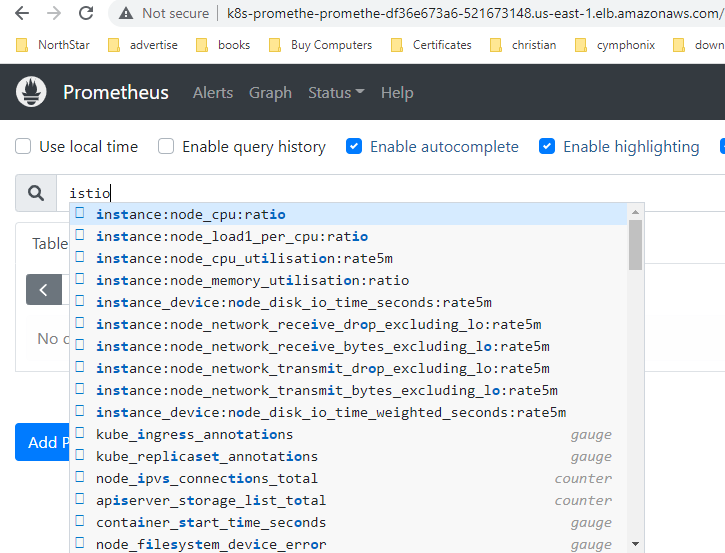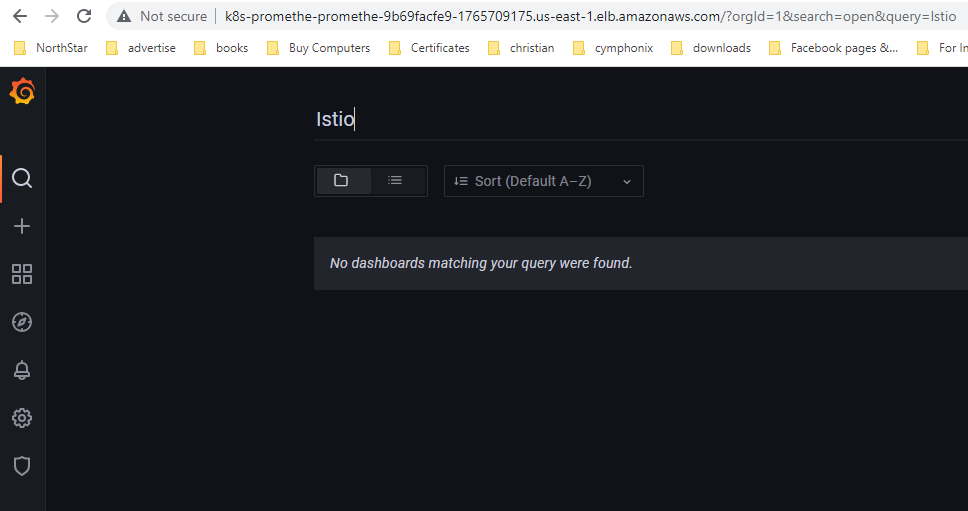Enabling ISTIO and Prometheus
After creating your cluster with the default addons that comes with the EKS Blueprints module example eks-cluster-with-new-vpc, you can enable or disable whatever addon you need, as long as it has a module for it under the directory modules/kubernetes-addons. You can ALSO create your own addon module, if there is no existing module already for it in the repository.
Now, let's enable the addons tetrate_istio and prometheus addon using EKS Blueprints that we'll need throughout this chapter.
Go into the module example directory if you are not there already, and open the main.tf file for editing.
cd examples/eks-cluster-with-new-vpc/
vi main.tf
Add the follwoing two lines under the eks_blueprints_kubernetes_addons to enable istio and prometheus on your cluster
enable_tetrate_istio = true
enable_prometheus = true
Like so:
module "eks_blueprints_kubernetes_addons" {
source = "../../modules/kubernetes-addons"
...
# Add-ons
enable_aws_load_balancer_controller = true
...
enable_tetrate_istio = true
enable_prometheus = true
tags = local.tags
}
Now, we need to configure the Prometheus module to use the Helm chart kube-prometheus-stack to enable Prometheus instead of the helm chart prometheus. That's becaue the chart kube-prometheus-stack installs Prometheus, in addition to Grafana and Prometheus-Operator that provides CRDs like ServiceMonitor and PodMonitor, which you are going to use in the next section for exposing ISTIO metrics to Prometheus.
The chart prometheus does not include those additional services. We also need to change the chart version to 35.3.1
To do so, open the main.tf file of the prometheus module located under modules/kubernetes-addons/prometheus/, and change the chart and version values under the helm_config section of the module helm_addon. In addition, replace the sub-value operating_system with ingressClassName as follow:
cd ../../modules/kubernetes-addons/prometheus/
vi main.tf
# module "helm_addon" {
module "helm_addon" {
...
helm_config = merge(
{
name = local.name
chart = "kube-prometheus-stack"
version = "35.3.1"
repository = "https://prometheus-community.github.io/helm-charts"
namespace = local.namespace_name
description = "Prometheus helm Chart deployment configuration"
values = [templatefile("${path.module}/values.yaml", {
#operating_system = try(var.helm_config.operating_system, "linux") # Remove this line
ingressClassName = "alb"
})]
},
var.helm_config
)
...
}
You install this chart with the default values, except the following values that you set to expose Grafana and Prometheus services using ALB.
To do so, you create a values.yaml file in the directory of the prometheus module, in the following path /modules/kubernetes-addons/prometheus/, which is the path that is already referenced in the values attribute under helm_config under module helm_addon in main.tf file (located in the prometheus module directory).
cat <<EOF > values.yaml
grafana:
ingress:
## If true, Grafana Ingress will be created
enabled: true
## IngressClassName for Grafana Ingress should be provided if Ingress is enable.
ingressClassName: ${ingressClassName}
## Annotations for Grafana Ingress
annotations: {
alb.ingress.kubernetes.io/scheme: "internet-facing",
alb.ingress.kubernetes.io/target-type: "ip"
}
pathType: Prefix
prometheus:
ingress:
enabled: true
ingressClassName: ${ingressClassName}
annotations: {
alb.ingress.kubernetes.io/scheme: "internet-facing",
alb.ingress.kubernetes.io/target-type: "ip"
}
pathType: Prefix
EOF
Note:
You may need to set values differently when running it in production. For a full list of values check this values.yaml that holds the default values that this chart has.
Next step, is to add the following value to the locals values in locals.tf located in modules/kubernetes-addons/aws-load-balancer-controller/, to enable creating ingress class resources which is needed to create the ALB of Grafana and Prometheus.
vi ../aws-load-balancer-controller/locals.tf
locals {
...
{
name = "createIngressClassResource"
value = true
}
...
}
Now you are all set to apply the resources of ISTIO and Prometheus to your EKS cluster
terraform apply
Wait for the resources to get applied to your cluster, and then you should be able seeing the services and pods of ISTIO and Prometheus in their respective namespaces.
kubectl get po,svc -n istio-system
Output:
NAME READY STATUS RESTARTS AGE
pod/istio-cni-node-5sb65 1/1 Running 0 61s
pod/istio-cni-node-jxqs7 1/1 Running 0 61s
pod/istio-cni-node-k226f 1/1 Running 0 61s
pod/istio-ingressgateway-5fc9f486fc-jt748 1/1 Running 0 42s
pod/istiod-776dbc9dc-7js84 1/1 Running 0 55s
NAME TYPE CLUSTER-IP EXTERNAL-IP PORT(S) AGE
service/istio-ingressgateway LoadBalancer 172.20.72.194 a59e84a877b5d45e8a6cf897a436a9a9-394493815.us-east-1.elb.amazonaws.com 15021:31196/TCP,80:32305/TCP,443:31608/TCP 42s
service/istiod ClusterIP 172.20.51.28 <none> 15010/TCP,15012/TCP,443/TCP,15014/TCP 56s
Enabling Istio will create a classic load balancer for Istio Ingress gateway as you notice in the preceeding output.
kubectl get po,svc -n prometheus
Output:
NAME READY STATUS RESTARTS AGE
pod/alertmanager-prometheus-kube-prometheus-alertmanager-0 2/2 Running 0 56s
pod/prometheus-grafana-69cd67cb67-mc6p9 3/3 Running 0 60s
pod/prometheus-kube-prometheus-operator-6794f987b-55ft8 1/1 Running 0 60s
pod/prometheus-kube-state-metrics-94f76f559-lbgr4 1/1 Running 0 60s
pod/prometheus-prometheus-kube-prometheus-prometheus-0 2/2 Running 0 56s
pod/prometheus-prometheus-node-exporter-pz8p5 1/1 Running 0 60s
pod/prometheus-prometheus-node-exporter-qdgjs 1/1 Running 0 60s
pod/prometheus-prometheus-node-exporter-vffgh 1/1 Running 0 60s
NAME TYPE CLUSTER-IP EXTERNAL-IP PORT(S) AGE
service/alertmanager-operated ClusterIP None <none> 9093/TCP,9094/TCP,9094/UDP 56s
service/prometheus-grafana ClusterIP 172.20.160.55 <none> 80/TCP 60s
service/prometheus-kube-prometheus-alertmanager ClusterIP 172.20.211.50 <none> 9093/TCP 60s
service/prometheus-kube-prometheus-operator ClusterIP 172.20.58.96 <none> 443/TCP 60s
service/prometheus-kube-prometheus-prometheus ClusterIP 172.20.4.219 <none> 9090/TCP 60s
service/prometheus-kube-state-metrics ClusterIP 172.20.87.244 <none> 8080/TCP 60s
service/prometheus-operated ClusterIP None <none> 9090/TCP 56s
service/prometheus-prometheus-node-exporter ClusterIP 172.20.180.230 <none> 9100/TCP 60s
Enabling Prometheus will create an application load balancer (ALB) for Promethes and Grafana, because that what we have passed to the helm chart to set while Installing the kube-prometheus-stack helm chart.

Test accessing the loadbalancer endpoint of Prometheus which should be up and running and then check if you can Istio metrics. It should show no Istio metrics yet, which would show in the next section Exposing ISTIO Metrics to Prometheus.

Test accessing the loadbalancer endpoints of Grafana oging to Grafana with the follwoing default credential (username: admin and password: prom-operator). Rememeber to change those default credentilas.
Grafana should be up and running. Check for ISTIO dashboards. It should show no Istio dashbpards yet, which would show in the next section Exposing ISTIO Metrics to Prometheus.

Next step, we need to expose ISTIO metrics to Pometheus.